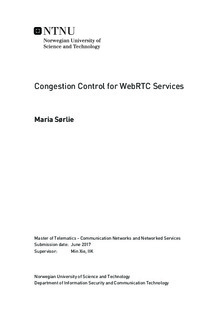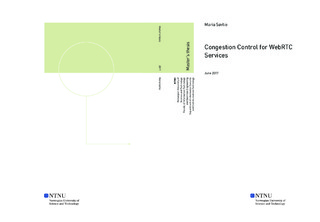| dc.description.abstract | Multimedia applications are increasing in popularity and using a big part
of the Internet traffic. Web Real-Time Communication (WebRTC) is
new technology which allows peer-to-peer communication in the browsers
without any extra plugins. The focus of this report is to determine the
importance of congestion control for the WebRTC-services.
In this thesis, I developed my own WebRTC-application. The developing
process contained research about features, protocols, and technologies
used. The final service was fully developed with audio and video features
for multimedia conversations. In addition, instant messaging was added
for assurance in case of communication problems.
Further, the developed WebRTC service were to conduct experiments.
The Experiments conducted where divided into two phases. First phase
tested the WebRTc service itself, to ensure the service was working
properly. Second phase consisted of 10 participants using the developed
service and give session feedback. I collected both session statistic data
and giving feedback from each session.
The experiments focused on the Quality of Service (QoS) and the user
perceived Quality of Experience (QoE), by looking at sent and received
bits and packets, packet loss rate and jitter values. I got an indication
of the QoS and if high values had an affect on how the user experienced
the session. Results show that it was the audio interruptions were most
heavily influenced by poor QoS.
Congestion control is a mechanism needed for transportation of data
across the Internet, to promote fair usage and prevent congestion collapse.
After looking at results from the experiments, a congestion control may
be needed. I have evaluated two WebRTC congestion controls, Google
Congestion Control (GCC) and Network Assisted Dynamic Adaption
(NADA), to fully understand how they operate.
The findings from experiments and the evaluation indicate a need
for a congestion control, and both GCC and NADA are found to be
appropriate congestion controllers.
Keywords WebRTC, Quality of Service, Quality of Experience, congestion
control, GCC, NADA, experiments. | |

